 As I’ve mentioned before, I have a particular affinity for the northwest side of town, where things always feel a bit more relaxed, the air smells fresher, and the mountains, so near, seem to be more a part of the neighborhoods’ fabric than elsewhere, interweaving themselves with the manmade structures erected in the spaces between them. Those mountains – Bukhan, Inwang, Ahn, Baeknyeon – exert control over this part of the city, dictating where buildings can be built, how neighborhoods can be shaped, and where transportation can be placed. The result is an expanse of the city where development takes longer and is more arduous, if it happens at all – subway stations are fewer and more scattered, large-scale commercial and residential complexes are fewer, and older communities last longer than they might elsewhere.
As I’ve mentioned before, I have a particular affinity for the northwest side of town, where things always feel a bit more relaxed, the air smells fresher, and the mountains, so near, seem to be more a part of the neighborhoods’ fabric than elsewhere, interweaving themselves with the manmade structures erected in the spaces between them. Those mountains – Bukhan, Inwang, Ahn, Baeknyeon – exert control over this part of the city, dictating where buildings can be built, how neighborhoods can be shaped, and where transportation can be placed. The result is an expanse of the city where development takes longer and is more arduous, if it happens at all – subway stations are fewer and more scattered, large-scale commercial and residential complexes are fewer, and older communities last longer than they might elsewhere.
I noticed those mountains as soon as I stepped out of the subway station, as they were as much a part of the skyline as Hongje’s buildings. Those buildings were of the kind commonly found in Seoul’s older neighborhoods: red brick or covered with a façade of off-white, nearly square tiles. In front of them people were out doing their grocery shopping and running other Sunday errands, and taking into account the surroundings there was of course no shortage of hikers in their bright mountain kits.
I bummed around the station for a while, through typical backstreets of small apartment buildings and homes, though one detour – out Exit 3 and right on Tong-il-ro-37-gil (통일로37길) – led me to the Seoul Arts-Occupational Training College (SART) (서울예술직업전문학교), where students studied in the hopes of forging careers in the entertainment industry. Large banners covered with aspiring idols advertised an exclusive audition for SART students with Pledis (플래디스) entertainment company.
Down the main drag I walked past phone shops, clothing stores, and sidewalk vendors selling produce, furniture, or bedding. Fruit and seafood trucks took up posts on corners. Outside a grocery store an older guy was hawking fruits and vegetables via a headset microphone that was connected to a battery-powered speaker he wore on a lanyard around his neck. The whole time the alternatingly forested and smooth-faced mass of Inwang Mountain (인왕산) rose up in the near distance.
Just a short distance from Exit 1 was Inwang Market (인왕시장), its main entrance a couple dozen meters down Inwang Market-gil (인왕시장길). The market, in a warehouse-like building, was almost entirely shut down when I arrived at around quarter to six in the evening. The lights were off, green and blue tarps were draped over unsold merchandise, and the water and ice had been emptied from their bins in the fish section. Still, the market smell was irremovable, the oceany tang of the seafood and the earthy sweetness of lettuce leaves suffusing the air even in the off hours. Near the entrance 14 shopping carts sat interlocked in a parking bay while next to them an unattended radio blared out trot at full volume for the two or three workers who were actually in the market. I couldn’t recall being in a market that was just shut down like that in a long time and I wondered why Inwang was until I spotted the sign over the entrance on my way out, notifying shoppers that it was closed the first and third Sundays of the month.
Not far away was the Hongje Stream (홍제천), which I got to from Exit 4, turning left on Yeonhee-ro (연희로) towards the Grand Hilton Hotel. As I headed down the road, the tall apartment towers on either side spaced themselves out and revealed a backdrop of sheer rock faces, the cliffs covered in netting bolted into them to prevent rockslides. The stream flowed under the enormous elevated Naebusunwhan-ro (내무순환로), so dominating that as I walked along the wide and shallow channel I almost felt as if I was indoors, like walking through one of those enclosed aviaries that some zoos have. Here, though, the bird life was limited to a few mallards, usually in pairs and more often than not with their heads in the water looking for something to eat. The stream tumbled over and around small rocks, and local residents utilized the biking path and exercise equipment. Those looking for something a bit more strenuous could head to Amsa Park (암사공원), just across the road, its steep approach seeming to make it more an expedition than a park, though.
Owing to the fact that mountains leave subway stations fewer and farther between in these parts, some attractions aren’t exactly within walking distance from the nearest stop, and at Hongje I had cause to jump on a few buses.
The first was 7738, bound for the Seodaemun Museum of Natural History (서대문자연사박물관). From Exit 3 I walked past guys selling bean husk pillows and egg bread (계란빵) up to the small Hongje Station (홍제역) bus stop (not the main one in the middle of Tong-il-ro). Once the bus came it wound up and down hilly roads, past murals and a school with a small garden on its grounds, and over the Hongje Stream once, twice, before arriving at Seodaemun Museum of Natural History Entrance (서대문자연사박물관) stop. When you get off directly in front of you will be Ansan City Nature Park (안산도시자연공원). To get to the museum cross the street and continue straight up the road, past the huge Korean Ginseng (한국고려인삼) building and the equally huge Woncheon Church on your left.
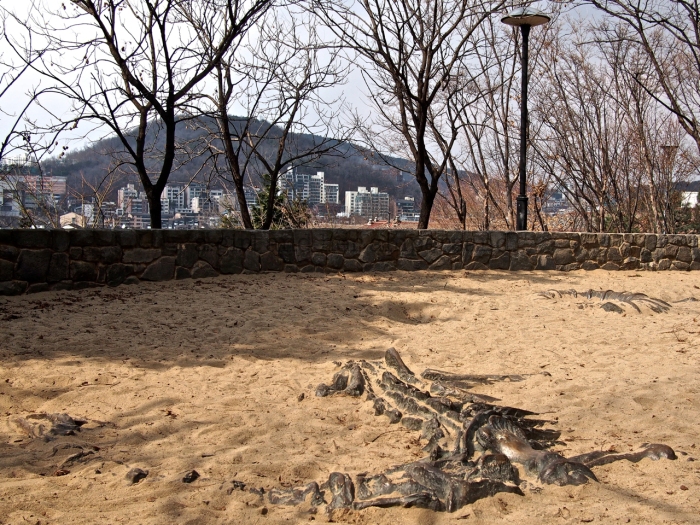 The museum’s target demographic is apparent as soon as you get close enough to hear the kids screaming in delight as they take turns going down the long yellow slide under the metal dinosaur skeleton sculpture outside. I’m pretty sure I was the only one in the museum who wasn’t there with a child or grandchild.
The museum’s target demographic is apparent as soon as you get close enough to hear the kids screaming in delight as they take turns going down the long yellow slide under the metal dinosaur skeleton sculpture outside. I’m pretty sure I was the only one in the museum who wasn’t there with a child or grandchild.
Inside, visitors are greeted by skeletons of an Acrocanthosaurus (similar to a T. Rex), a Spinosaurus, and, dangling overhead, those of a Pteranodon, pterodactyl, and prehistoric fish, along with models of two sperm whales. Displays begin on the third floor’s Earth Environment Hall (지구환경관) with a 3D movie of the birth of Earth and continue through exhibits on the solar system, atmosphere, and rocks and minerals, which captivated one budding geologist so much that he was photographing every single different mineral that was on display, shuffling sideways in a half-squat, methodically working his way through the catalogue. Also on the third floor is the Dinosaur Park, an outdoor patio were kids act cute on dinosaur statues and in hatching eggs and parents take pictures.


 The second floor is the Life Evolution Hall (생명진화관), covering the history of life on the planet, from its inception in the Precambrian era to the present day, with plenty of space given over to dinosaurs: fossils, statues, videos, roars. On a picture of prehistoric animals from around the world someone had taken the liberty of drawing moustaches on the leopards, lemurs and other animals. We here at Seoul Sub-urban would like to point out that this is vandalism and we in no way condone such actions. We also acknowledge, however, that it is hilarious. Stuffed animals, amphibians, and fish, and mounted insects and butterflies round out the displays.
The second floor is the Life Evolution Hall (생명진화관), covering the history of life on the planet, from its inception in the Precambrian era to the present day, with plenty of space given over to dinosaurs: fossils, statues, videos, roars. On a picture of prehistoric animals from around the world someone had taken the liberty of drawing moustaches on the leopards, lemurs and other animals. We here at Seoul Sub-urban would like to point out that this is vandalism and we in no way condone such actions. We also acknowledge, however, that it is hilarious. Stuffed animals, amphibians, and fish, and mounted insects and butterflies round out the displays.
The Human & Nature Hall (인간과자연관) on the first floor showcases peninsular ecology, with displays on Korea’s forests and the fish of the Han River. It also emphasizes the ‘Be good stewards, kids!’ message with sections on endangered species and humans’ impact on the environment.

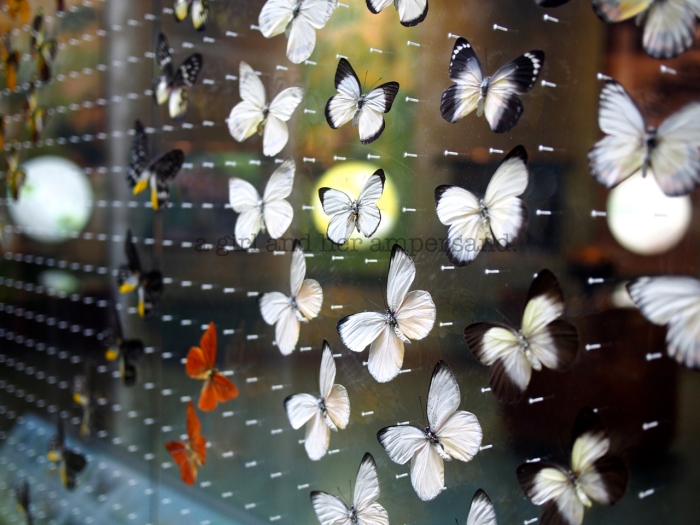 In addition to the displays, SMNH offers other programs and services for local kids, including a library, a fossil excavation garden, field trips, and various classes. One additional program that I thought was incredibly cool was the child docent program, where kids from the fourth grade of elementary school to the third grade of middle school can be trained as museum docents and then lead tours for other kids. This immediately became the number one tour I want to go on in the entire world.
In addition to the displays, SMNH offers other programs and services for local kids, including a library, a fossil excavation garden, field trips, and various classes. One additional program that I thought was incredibly cool was the child docent program, where kids from the fourth grade of elementary school to the third grade of middle school can be trained as museum docents and then lead tours for other kids. This immediately became the number one tour I want to go on in the entire world.
The last bus I took was the number 7 maeul bus from the stop just behind the elevator after U-turning out Exit 1. I was headed for Gaemi Maeul (개미마을), one of the city’s remaining daldongnae (달동내). In the wake of the Korean War, displaced residents and new arrivals poured into Seoul. While the wealthy claimed the valleys, the poor had to find space to live on the mountain slopes on the city’s edges, settling in rough communities that came to be known by the rather overly poetic euphemism daldongnae, meaning ‘moon village’ so named for their closer view of the moon. One such moon village was Gaemi Maul, which initially began as a collection of pitched tents before more stable dwellings were constructed.
The very same features that made it possible to establish these communities in the first place – their remoteness, their difficult terrain – have ensured that many of them have stayed undeveloped and impoverished. Today, Gaemi Maeul is representative of what daldongnae are in twenty-first century Seoul: isolated, largely forgotten about, and caught in a ‘will they or won’t they’ limbo in regards to redevelopment. In addition to the terrain, Gaemi Maeul was held in place by a long-lasting restriction on development as part of a city effort to preserve the natural environment, though this restriction was lifted in 2007. (Some suspect that construction here has also been prevented, or at least complicated, by the neighborhood’s proximity to the Blue House (청와대).) No matter. For now at least the mountain still holds sway, dictating what can and cannot be built upon it.

 One feature of the neighborhood sets it apart, though, and has turned it into an unexpected tourist attraction. Similar to Iwha-dong, Gaemi Maeul was the recipient of an urban art project, this one sponsored by Kumho Engineering and Construction, where local university students filled its walls and stairways with colorful murals, a cosmetic refashioning that’s made it a popular spot for couples on dates and high school girls, anyone with a predilection for having their photo taken, really.
One feature of the neighborhood sets it apart, though, and has turned it into an unexpected tourist attraction. Similar to Iwha-dong, Gaemi Maeul was the recipient of an urban art project, this one sponsored by Kumho Engineering and Construction, where local university students filled its walls and stairways with colorful murals, a cosmetic refashioning that’s made it a popular spot for couples on dates and high school girls, anyone with a predilection for having their photo taken, really.
Departing from Hongje Station, the little green 7 headed north and then up, up, up, on a slope that was probably 30 degrees in places, winding through the run-down neighborhood until it reached its last stop, a turnaround at the top of the village. Along with some local residents and a couple hikers, three couples stepped out of the bus, cameras in hand. The view from the turnaround was incredible, extending over Seodaemun-gu, and I immediately understood why some had their eye on the place for redevelopment. Above the turnaround a park with walking paths leading up into Inwang Mountain started. I began to make my way up, passing a fat woman making her way down inch by inch, clutching a hiking stick and the rock wall as she descended. A sign pointed to Gicha Rock Ridge (기차바위능선) 600 meters away. I started heading for it, but after a steep 200 meters the path looked to get even steeper and I gave up, turning back toward the village and feeling a new admiration for the fat woman. Those hardier than me can follow trails over the mountain, into Buam-dong, and down to Gyeongbok Palace.
 Compared to Gaemi Maeul, Hongje-dong had been a din. Here I felt like I was in the countryside. From somewhere came the crowing of a rooster and a minute later a snarling dog from somewhere else. Heading toward the village from the bus turnaround I saw an empty plastic bucket run bumping and tumbling down a curving flight of concrete stairs in the hillside, following their course perfectly as it fell. A moment later a man in a denim jumpsuit and a sideways baseball cap appeared at the top (the man who’d dropped the bucket in the first place, presumably) leisurely going down the steps after it, knowing that there was no use hurrying. It’d be at the bottom waiting for him.
Compared to Gaemi Maeul, Hongje-dong had been a din. Here I felt like I was in the countryside. From somewhere came the crowing of a rooster and a minute later a snarling dog from somewhere else. Heading toward the village from the bus turnaround I saw an empty plastic bucket run bumping and tumbling down a curving flight of concrete stairs in the hillside, following their course perfectly as it fell. A moment later a man in a denim jumpsuit and a sideways baseball cap appeared at the top (the man who’d dropped the bucket in the first place, presumably) leisurely going down the steps after it, knowing that there was no use hurrying. It’d be at the bottom waiting for him.
On a wall where the village began was a picture of a rabbit in a raincoat and his Jindo dog friend, dressed in a shirt and tie and saying, ‘Let’s GO!’ I took his advice and headed into the village. There was a stark contrast between the glum condition of the homes here and the incongruous bursts of colorful paint depicting bright abstract patterns, flowers, or cows, pigs, and dogs in picture frames floating in the clouds. Far below I could see the traffic on the expressway bridge and a huge KT building, but here many of the homes had outdoor toilets, corrugated metal roofs covered by tarps, wooden boxes and plastic bins for growing vegetables, and small piles of use grayish-pink charcoal heating briquettes tossed in backyards.
Walking around, I passed a wall with SpongeBob and Steven and a snail friend crawling across a rainbow, and in another corner of the neighborhood I walked past a house where a small watercourse down the mountain ran directly behind it, its quiet trickle audible in the still air. A wooden plank was laid over the watercourse, connecting the house to its garden, and a black and white cat napped beside it. A sign on the street past the house pointed to Gwan-am Temple (관암사), and I followed it up toward a small pagoda, next to which was Gwan-am, looking more like a trailer than a temple.
As of 2011, around 400 people lived in Gaemi Maeul, but it seemed like that number was lower now. Many of the homes here sat empty, having been bought by wealthy speculators from Gangnam and elsewhere, hoping to cash in on the jump in real estate prices if the area is ever transformed into new apartment complexes. Most of those left were in their 50s or 60s, at least, and many of the residents here rely upon government welfare. I was getting thirsty from walking up and down the steep streets and popped into one of the tiny convenience stores on the main road. Inside, about one-third of the space was occupied by a raised floor where the elderly proprietors were watching TV, the man sitting cross-legged, his wife laying down, neither bothering to get up when I entered, thankfully. Given the economic circumstances of the neighborhood, I thought it likely that they lived there, and if I was stepping into their home I certainly didn’t want them disturbing themselves on my account. As for the few square feet of the shop, its size and lack of merchandise or variety reminded me of similar stores in third world countries I’d visited, where the question upon entering was never what I wanted, but what it was possible to get.
That parallel made me ponder another question. The couples and amateur photographers and groups of schoolgirls who took the number 7 bus up here to take their photos in front of the murals and homes from decades past, and me too for that matter…well, was this slum tourism? Certainly, the people with cameras slung around their necks and smartphones held at arm’s length were here nominally for the art, but it was the poverty of the neighborhood that instigated the murals, and their effect was due entirely to the contrast between them and the buildings they were painted on. Gaemi Maeul means ‘Ant Village,’ its name intended to describe the diligence of its residents. With so many neighbors now gone, with facilities so simple, with streets so steep, the villagers who remained needed every bit of that diligence to make it here on the side of the mountain. More than simply providing a photograph-worthy backdrop, the murals most positive effect may be to bring people here to see and understand that.
Seoul Arts-Occupational Training College (SART) (서울예술직업전문학교)
Exit 3
Right on Tong-il-ro-37-gil (통일로37길)
Inwang Market (인왕시장)
Exit 1
Right on Inwang Market-gil (인왕시장길)
Hongje Stream (홍제천)
Exit 4
Left on Yeonhee-ro (연희로)
Amsa Park (암사공원)
Exit 4
Left on Yeonhee-ro (연희로)
Seodaemun Museum of Natural History (서대문자연사박물관) and Ansan City Nature Park (안산도시자연공원)
Exit 3
Straight to Hongje Station (홍제역) bus stop, Take bus 7738 to Seodaemun Museum of Natural History Entrance (서대문자연사박물관) stop
02) 330-8899
namu.sdm.go.kr
Hours | March – October 9:00 – 18:00, November – February 9:00 – 17:00 (Opening hours extended by one hour on weekends and holidays); Closed Mondays, New Year’s Day, Seollal, Chuseok, and Tuesdays when Monday is a holiday
Admission | Adults – 3,000; Youth (13-18) and Soldiers – 2,000; Children (5-12) – 1,000; Kids under 5, Senior Citizens, and the Handicapped – Free; Seodaemun residents receive a 50% discount
Gaemi Maeul (개미마을)
Exit 1
U-turn, Take maeul bus 7 to the last stop





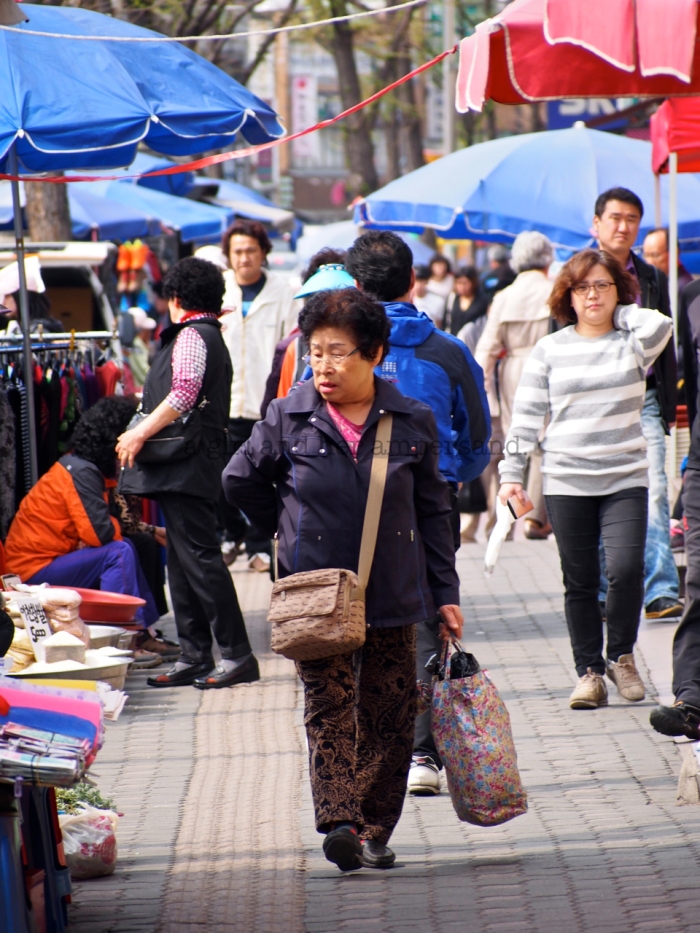





















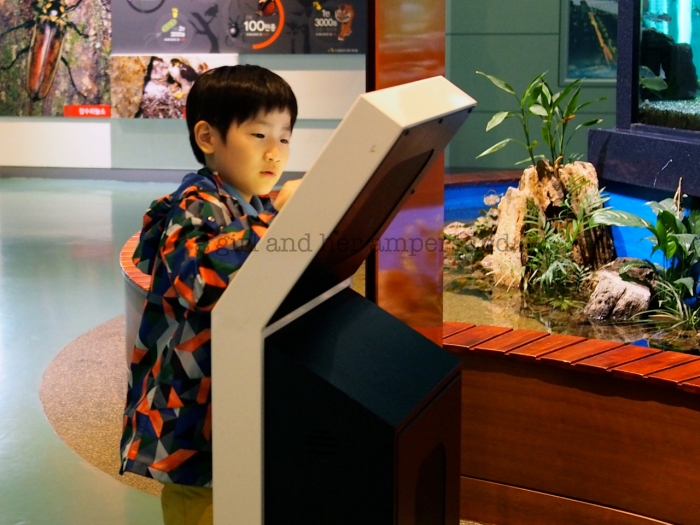












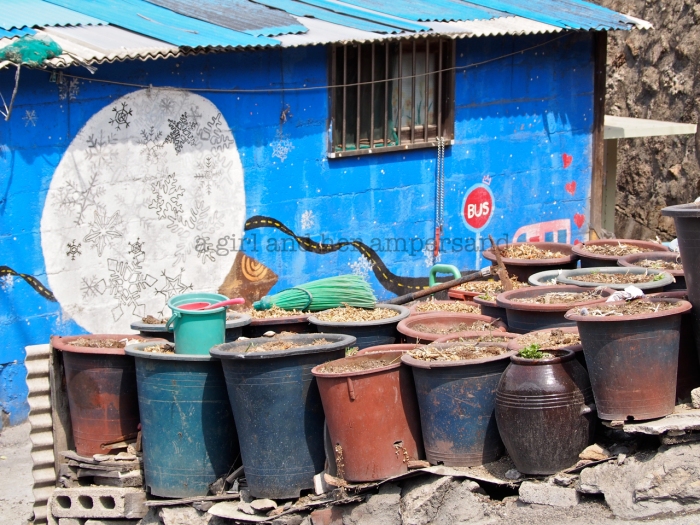










Pingback: SEOUL Weekly: SEOUL July Issue | SEOUL Magazine
Thank you for this photo-journey of the area off of this train station. Our daughter moved there 1 month ago from the US and forwarded this to us so we could see the sights around her new home.
Hi Gordon, thanks for the comment! Glad you enjoyed it. Hope your daughter is enjoying Hongje. It’s an interesting neighborhood.
I live in Hongundong, near Hongje Station, and I enjoyed very much for your covering this area. Thank you !
No problem Bumso! Glad you liked it!
Pingback: Hidden Things to Do in Seoul and How to Find Them | South Korea Travel